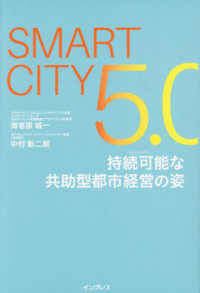- ホーム
- > 洋書
- > 英文書
- > Architecture
Full Description
This is the first comprehensive study of the reception of classical architecture in different regions of the world. Exploring the impact of colonialism, trade, slavery, religious missions, political ideology and intellectual/artistic exchange, the authors demonstrate how classical principles and ideas were disseminated and received across the globe. By addressing a number of contentious or unresolved issues highlighted in some historical surveys of architecture, the chapters presented in this volume question long-held assumptions about the notion of a universally accepted 'classical tradition' and its broadly Euro-centric perspective.
Featuring thirty-two chapters written by international scholars from China, Europe, Turkey, North America, Mexico, Australia and New Zealand, the book is divided into four sections: 1) Transmission and re-conceptualisation of classical architecture; 2) Classical influence through colonialism, political ideology and religious conversion; 3) Historiographical surveys of geographical regions; and 4) Visual and textual discourses. This fourfold arrangement of chapters provides a coherent structure to accommodate different perspectives of classical reception across the world, and their geographical, ethnographic, ideological, symbolic, social and cultural contexts. Essays cover a wide geography and include studies in Italy, France, England, Scotland, the Nordic countries, Greece, Austria, Portugal, Romania, Germany, Poland, India, Singapore, China, the USA, Mexico, Brazil, New Zealand and Australia. Other essays in the volume focus on thematic issues or topics pertaining to classical architecture, such as ornament, spolia, humanism, nature, moderation, decorum, heresy and taste.
An essential reference guide, The Routledge Handbook on the Reception of Classical Architecture makes a major contribution to the study of architectural history in a new global context.
Contents
1. Introduction: A 'World' Reception of Classical Architecture Nicholas Temple, Andrzej Piotrowski and Juan Manuel HerediaPART I: TRANSMISSION AND RE-CONCEPTUALISATION OF CLASSICAL ARCHITECTURE 2.The Fates of Fornix Juan Manuel Heredia 3. Architects, Architecture and the City: Some Themes on the Continuity of Classical Ideas Relating to the Latin Middle Ages Christian Frost 4. Rethinking Ornament in Classical Architecture: Spolia and Architecture as institutio Clare E. L. Guest 5. The Persistence of Natura Naturans from Classical Architecture John Hendrix 6. On Moderation: The Ancient Virtue and its Reception in Architectural Theory Esra Sahin Burat 7. Classical Columns, Mannerism, and the Other Antiquity Andrzej Piotrowski 8. Neoclassical Taste and Antiquarian Scholarship: The Royal Academy of the Three Noble Arts of San Carlos in Mexico, Alexander von Humboldt and Pedro José Márquez Oscar Humberto Flores 9. Eighteenth and Nineteenth Century Classicism in England: John Soane's Language and ImaginationYue Zhuang PART II: CLASSICAL INFLUENCES THROUGH COLONIALISM, POLITICAL IDEOLOGY AND RELIGIOUS CONVERSION 10. Honour and the Classical Tradition in Architecture: The Matter of Slavery Charles Burroughs 11. Dismemberment of the Orders and their Reassembly across Portuguese Overseas Settlements Pedro Guedes 12. The Reception and Involution of Classical Architecture in Jesuit Missions in China (1583-1759) Xiao Jing 13. The Gods that came from the Sea: The Classical Tradition in New Spain Santiago de Orduña 14. Indo-Portuguese Architecture in Kerala during the Sixteenth and Seventeenth Centuries Helder Carita 15. Neo-classical Architecture in the Straits Settlements: Singapore's Civic Square (1819







